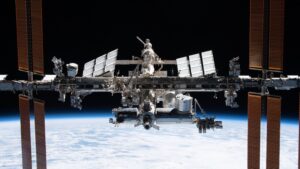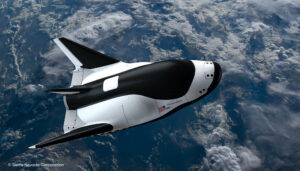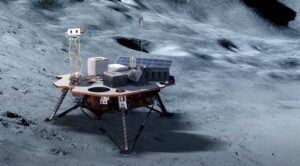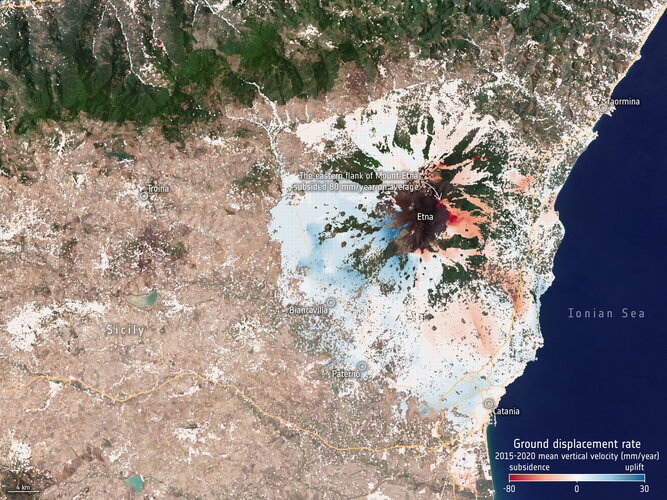Lunar Reconnaissance Orbiter finds lunar pits harbor comfortable temperatures
Tuesday, 26 July 2022 16:14
NASA-funded scientists have discovered shaded locations within pits on the Moon that always hover around a comfortable 63 F (about 17 C) using data from NASA's Lunar Reconnaissance Orbiter (LRO) spacecraft and computer modeling.
The pits, and caves to which they may lead, would make thermally stable sites for lunar exploration compared to areas at the Moon's surface, which heat up to 260 F (about 127 C) during the day and cool to minus 280 F (about minus 173 C) at night.
NASA: no notification by Russia to end ISS participation
Tuesday, 26 July 2022 15:45
NASA officials said July 26 they have received no official notification from Roscosmos of plans to end cooperation on the International Space Station despite comments from that agency’s new leader.
The post NASA: no notification by Russia to end ISS participation appeared first on SpaceNews.
Sierra Space establishes national security advisory group
Tuesday, 26 July 2022 13:00
Sierra Space has created a group of former government officials, including a retired vice chairman of the Joint Chiefs of Staff and a NASA deputy administrator, to advise the company as it seeks to win national security business.
NASA says no 'official word' from Russia on quitting ISS
Tuesday, 26 July 2022 12:49
The United States hasn't received "any official word" from Russia on its just-announced plans to quit the International Space Station "after 2024," a senior NASA official said Tuesday.
"We haven't received any official word from the partner as to the news today," director of the ISS for NASA, Robyn Gatens, said during a conference on the outpost.
NASA itself plans to retire the ISS—a symbol of post Cold War unity—after 2030 as it transitions to working with commercial space stations, and Gatens suggested Russia might be thinking about its own transition.
Asked whether she wanted the US-Russia space relationship to end, she replied: "No, absolutely not."
"They have been good partners, as all of our partners are, and we want to continue together as the partnership to continue operating space station through the decade."
Gatens was responding to an announcement by newly appointed Roscosmos chief Yury Borisov.
"Of course, we will fulfill all our obligations to our partners, but the decision to leave this station after 2024 has been made," Borisov told Russian President Vladimir Putin.
"I think that by this time we will start putting together a Russian orbital station," Borisov added, calling it the space program's main "priority.
Orbit Fab to donate regolith to lunar resources trust
Tuesday, 26 July 2022 12:00
Orbit Fab, a startup that is developing an infrastructure for in-space refueling of spacecraft, announced plans to purchase a small amount of lunar regolith and transfer it to a trust to promote sustainable management of lunar resources.
Tap into Europe in motion
Tuesday, 26 July 2022 11:48
Any movement beneath our feet – from barely perceptible subsidence to the sudden appearance of a sinkhole or a crashing landslide – spells big trouble. Even relatively modest subsidence can weaken buildings and infrastructure and lead to issues such as flooding, and at worst the abrupt disappearance of sections of land brings immediate threat to life. Monitoring and predicting our shifting land is clearly essential for adopting mitigating strategies.
And now, thanks to Europe’s environmental Copernicus programme and the Sentinel-1 radar satellite mission, the first Europe-wide subsidence and soil movement analysis service is available to the public.
Russia to quit International Space Station 'after 2024'
Tuesday, 26 July 2022 11:15 Russia has decided to quit the International Space Station "after 2024", the newly-appointed chief of Moscow's space agency told President Vladimir Putin on Tuesday.
"Of course, we will fulfil all our obligations to our partners, but the decision to leave this station after 2024 has been made," Roscosmos chief Yury Borisov told Putin in comments released by the Kremlin.
Russia has decided to quit the International Space Station "after 2024", the newly-appointed chief of Moscow's space agency told President Vladimir Putin on Tuesday.
"Of course, we will fulfil all our obligations to our partners, but the decision to leave this station after 2024 has been made," Roscosmos chief Yury Borisov told Putin in comments released by the Kremlin. Preparing for the World's biggest radio telescope
Tuesday, 26 July 2022 11:15 An international team of researchers has demonstrated that the Square Kilometre Array Observatory (SKAO) is capable of detecting radio emissions from normal spiral galaxies in the early universe. The SKAO, whose construction began this year, will soon be the largest radio telescope in the world. The astronomers, who are part of the SKAO's "Extragalactic Continuum" working group, are looking for
An international team of researchers has demonstrated that the Square Kilometre Array Observatory (SKAO) is capable of detecting radio emissions from normal spiral galaxies in the early universe. The SKAO, whose construction began this year, will soon be the largest radio telescope in the world. The astronomers, who are part of the SKAO's "Extragalactic Continuum" working group, are looking for Eutelsat, OneWeb plan to merge
Tuesday, 26 July 2022 11:15 French and British satellite operators Eutelsat and OneWeb on Tuesday announced plans to merge and create a "global champion" in the fast-growing broadband internet market, rivalling US giants such as Elon Musk's Starlink.
Eutelsat and OneWeb said in a joint statement they had signed a memorandum of understanding to join forces to become "a leading global player in connectivity... in an all-
French and British satellite operators Eutelsat and OneWeb on Tuesday announced plans to merge and create a "global champion" in the fast-growing broadband internet market, rivalling US giants such as Elon Musk's Starlink.
Eutelsat and OneWeb said in a joint statement they had signed a memorandum of understanding to join forces to become "a leading global player in connectivity... in an all- Terran Orbital completes Space-to-Ground Optical Link demonstration on Pathfinder Technology Demonstrator 3
Tuesday, 26 July 2022 11:15 Terran Orbital Corporation (NYSE: LLAP), a global leader in satellite solutions, primarily serving the United States and Allied aerospace and defense industries, has announced the first signal acquisition of the Terabyte Infrared Delivery (TBIRD) Lasercom Optical Link on NASA's Pathfinder Technology Demonstrator 3 (PTD-3) satellite.
Acquisition of the Lasercom Optical Link means that the s
Terran Orbital Corporation (NYSE: LLAP), a global leader in satellite solutions, primarily serving the United States and Allied aerospace and defense industries, has announced the first signal acquisition of the Terabyte Infrared Delivery (TBIRD) Lasercom Optical Link on NASA's Pathfinder Technology Demonstrator 3 (PTD-3) satellite.
Acquisition of the Lasercom Optical Link means that the s US-European satellite will make world's first global freshwater survey
Tuesday, 26 July 2022 11:15 Water is life, but for all its importance, humanity has a surprisingly limited view of Earth's freshwater bodies. Researchers have reliable water level measurements for only a few thousand lakes around the world, and little to no data on some of the planet's important river systems. The upcoming Surface Water and Ocean Topography (SWOT) satellite will fill that enormous gap. By helping to provid
Water is life, but for all its importance, humanity has a surprisingly limited view of Earth's freshwater bodies. Researchers have reliable water level measurements for only a few thousand lakes around the world, and little to no data on some of the planet's important river systems. The upcoming Surface Water and Ocean Topography (SWOT) satellite will fill that enormous gap. By helping to provid NOAA contracts with Planet to image oil spills, marine debris, and marine life
Tuesday, 26 July 2022 11:15 Planet Labs PBC (NYSE: PL), a leading provider of daily data and insights about Earth, has announced a new contract with the National Oceanic and Atmospheric Administration (NOAA). The organization is leveraging Planet's PlanetScope and SkySat products to evaluate oil spills, track marine debris, detect vessels, and identify large marine mammals like whales.
In 2004, Hurricane Ivan caused
Planet Labs PBC (NYSE: PL), a leading provider of daily data and insights about Earth, has announced a new contract with the National Oceanic and Atmospheric Administration (NOAA). The organization is leveraging Planet's PlanetScope and SkySat products to evaluate oil spills, track marine debris, detect vessels, and identify large marine mammals like whales.
In 2004, Hurricane Ivan caused Sols 3541-3543: Teamwork? Sure!
Tuesday, 26 July 2022 11:15 Some planning days are more complicated than others, not because Mars throws us a curve ball, that happens, too, as regular readers of this blog will know. No, sometimes it's just plain old computer issues here on Earth that make things complicated. Today was such a day, and some of our personal computers hadn't properly updated one of the tools, but when we found out it was too late to diagnose
Some planning days are more complicated than others, not because Mars throws us a curve ball, that happens, too, as regular readers of this blog will know. No, sometimes it's just plain old computer issues here on Earth that make things complicated. Today was such a day, and some of our personal computers hadn't properly updated one of the tools, but when we found out it was too late to diagnose Study: Explosive volcanic eruption produced rare mineral on Mars
Tuesday, 26 July 2022 11:15 Planetary scientists from Rice University, NASA's Johnson Space Center and the California Institute of Technology have an answer to a mystery that's puzzled the Mars research community since NASA's Curiosity rover discovered a mineral called tridymite in Gale Crater in 2016.
Tridymite is a high-temperature, low-pressure form of quartz that is extremely rare on Earth, and it wasn't immediat
Planetary scientists from Rice University, NASA's Johnson Space Center and the California Institute of Technology have an answer to a mystery that's puzzled the Mars research community since NASA's Curiosity rover discovered a mineral called tridymite in Gale Crater in 2016.
Tridymite is a high-temperature, low-pressure form of quartz that is extremely rare on Earth, and it wasn't immediat Space For Humanity will send first Egyptian to space via Blue Origin
Tuesday, 26 July 2022 11:15 Today, Space For Humanity (S4H), a 501(c)(3) nonprofit organization, announced its selection committee has chosen Sara Sabry to become the organization's second sponsored Citizen Astronaut. Sara will become the first Egyptian to fly to space when she flies aboard Blue Origin's NS-22 flight.
Sara, 29, is an Egyptian mechanical and biomedical engineer and founder of Deep Space Initiative (DS
Today, Space For Humanity (S4H), a 501(c)(3) nonprofit organization, announced its selection committee has chosen Sara Sabry to become the organization's second sponsored Citizen Astronaut. Sara will become the first Egyptian to fly to space when she flies aboard Blue Origin's NS-22 flight.
Sara, 29, is an Egyptian mechanical and biomedical engineer and founder of Deep Space Initiative (DS 
